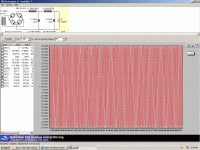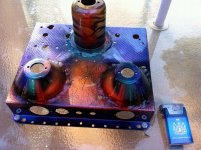I have been collecting parts for a spud amp and have a PTX with 6.3v and 5v but the two 380v legs are not center taped. So, can this be used in an amp? I've not seen a scheem without a center tape on the main primaries.
Yes, use a bridge rectifier. Your off load voltage will be 1.414 times the primary ie. 537.32 volts, so you need to ensure your filter capacitor can cope with this (and your tubes for that matter)
Thanks Doz. This amp chassis is a work of art (I am a metal sculptor) so it is pretty much set up for a tube rec. I think I should just wait for a CT PTX of the approp. voltage. The tubes really can't go that high anyway so I would have to knock it down....to much trouble.
A choke input PSU would give you 90% of the transformer voltage, instead of 140% with capacitor input. Do you have room for a choke?
Right now I have two 8mh chokes in a CLCLC configuration. So I might be able to switch that around???
Stupid question, but does a bridge rectifer HAVE to be SS or can it be tube as well?
Stupid question, but does a bridge rectifer HAVE to be SS or can it be tube as well?
OK, I just whipped this up in PSU II with the two chokes I have and it looks a little low for the tubes I am using. They are the 6LR8. I need to think about 1. if this is enough voltage and 2. do I have room for 2 rec tubes.
Are there any rectifier tubes that have 4 elements in them?
Are there any rectifier tubes that have 4 elements in them?
Attachments
I have been collecting parts for a spud amp and have a PTX with 6.3v and 5v but the two 380v legs are not center taped. So, can this be used in an amp? I've not seen a scheem without a center tape on the main primaries.
A bridge recifier requires four diodes. I would work fine. But with a center tap you only need two diodes. Back in the old days of tube rectifiers no one wanted to build a full wave bridge because it doubled the number of rectifier tubes. But now that solid state diodes cost just 10 cents each it is not such a big deal.
So I'd say use the non-tapped transformer if you are going with SS diodes. If using rectifier tubes, get a CT transformer.
OK, I just whipped this up in PSU II with the two chokes I have and it looks a little low for the tubes I am using. They are the 6LR8. I need to think about 1. if this is enough voltage and 2. do I have room for 2 rec tubes.
Are there any rectifier tubes that have 4 elements in them?
You could try a hybrid bridge rectifier.
The Valve Wizard
Maybe?
That is an interesting idea J. I don't know why it wouldn't work. I don't think I can modle it in PSU but maybe a little bench testing would be in order.
That is an interesting idea J. I don't know why it wouldn't work. I don't think I can modle it in PSU but maybe a little bench testing would be in order.
Go for it! It is not something I have tried either, I just remembered reading about it, so found the website for you. Let me know if it flies. DIY at its finest is just trying it, right?
OK, I just whipped this up in PSU II with the two chokes I have and it looks a little low for the tubes I am using. They are the 6LR8. I need to think about 1. if this is enough voltage and 2. do I have room for 2 rec tubes.
Are there any rectifier tubes that have 4 elements in them?
More then just four diodes in one envelope, you need to find a rectifier that does not have a shared cathode. The bridge needs to look just like in the PSU II diagram, four plates and four cathodes. Two "normal" tube rectifiers can't work
If the voltage is low use SS diodes
Go for it! It is not something I have tried either, I just remembered reading about it, so found the website for you. Let me know if it flies. DIY at its finest is just trying it, right?
Yep, I think this is the solution. I get the high voltage, no more than one tube, can use my current chassis and rec tube. AND, my 5v is center tapped so I can draw the B+ off that for lower noise. Great find.
More then just four diodes in one envelope, you need to find a rectifier that does not have a shared cathode. The bridge needs to look just like in the PSU II diagram, four plates and four cathodes. Two "normal" tube rectifiers can't work
If the voltage is low use SS diodes
That makes sense Chris. That puts it into the "unusable" catagory.
This worked like a charm for me - I built several little mono block pairs and stereo EL84 amps at least 5 yrs ago with a similar implementation in the power supply. Choke filtered supplies with Solen film caps and reclaimed iron from several vintage large console radios, etc.
They've seen pretty much constant daily use since then, with nary a problem.
Astute surfers might recognize the audio portion of circuit
Attachments
First, are the transformer and choke resistance values close? If not, adjust to match reality and model it with 4 vacuum rectifiers, then with 4 solid state ones. Average the two to see what you'll have with the hybrid bridge. BTW, I'd look for a HV secondary with less than 150 Ohms DCR for 100 mA.
Thanks Doz. This amp chassis is a work of art (I am a metal sculptor) so it is pretty much set up for a tube rec. I think I should just wait for a CT PTX of the approp. voltage. The tubes really can't go that high anyway so I would have to knock it down....to much trouble.
Do we get to see pictures?? Sounds great.
I've used Hybrid rectifiers in a small pre-amp when I lacked the appropriate transformer. Worked well enough.
I must rather lash something up on the bench than model, but I'm just like that... I spend 70% of my waking hours pushing buttons on a keyboard, so I'd rather spend the other 30% with an iron in one hand ... and the warm smell of tubes 😀
Do we get to see pictures?? Sounds great.
I've used Hybrid rectifiers in a small pre-amp when I lacked the appropriate transformer. Worked well enough.
I must rather lash something up on the bench than model, but I'm just like that... I spend 70% of my waking hours pushing buttons on a keyboard, so I'd rather spend the other 30% with an iron in one hand ... and the warm smell of tubes 😀
Yep, me too..click click click all day long. Nice to melt solder at night.
Here is the amp all painted up. the rec tube goes in back on the tube and the 6LR8s go up on the twin peaks.
Attachments
Yep, me too..click click click all day long. Nice to melt solder at night.
Here is the amp all painted up. the rec tube goes in back on the tube and the 6LR8s go up on the twin peaks.
Awesome, not quite what I expected... I thought polished stainless and mayby some rusty steel .... did you smoke the cigarettes lit from the freshly cooling weld... something I always do when mig welding some ancient relic of british motor history back together!!!
Love it...
This worked like a charm for me - I built several little mono block pairs and stereo EL84 amps at least 5 yrs ago with a similar implementation in the power supply. Choke filtered supplies with Solen film caps and reclaimed iron from several vintage large console radios, etc.
They've seen pretty much constant daily use since then, with nary a problem.
Astute surfers might recognize the audio portion of circuit
Seeing this an hearing your experience gives me hope and confidence Chris. I think I will wire this up tomorrow and see what happens.
First, are the transformer and choke resistance values close? If not, adjust to match reality and model it with 4 vacuum rectifiers, then with 4 solid state ones. Average the two to see what you'll have with the hybrid bridge. BTW, I'd look for a HV secondary with less than 150 Ohms DCR for 100 mA.
Great, thanks Tom. This is a great starting point. The PTX is 38ohms and the chokes are 152ohms, so I will be using your method. I'll be able to measure the voltage after bread boarding, but not the ripple.
- Status
- Not open for further replies.
- Home
- Amplifiers
- Tubes / Valves
- will a PTX without center tap work?

